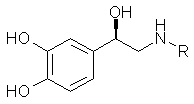










|
|
Adrenaline (C9H13NO3) is a catecholamine and
belongs to the family of biogenic amines. It forms colourless to white crystalls (mp:
211-212 °C). Adrenaline is air and light sensitive and forms dark products during
decomposition.
For more general information (CAS-Nr., names, ...) follow
this link.
|

|
| R = H |
Noradrenaline |
| R = CH3 |
Adrenaline |
|
L-adrenaline has some important biological functions. On the one hand, it belongs, like
the chemically related noradrenaline, to the family of adrenal medulla hormones.
The hormone has a big influence on the storage and mobilisation of glycogene and
fatty acids and the corresponding metabolic pathways (see
biological function).
On the other hand, adrenaline is a neurotransmitter of the adrenergic nervous system.
It has an effect on  -
and -
and  -rezeptors
(see biological function). -rezeptors
(see biological function).

|
History
L-adrenaline was isolated from adrenal medulla (name (lat.): adrenes)
by two independent groups (Takamine, Aldrich and von Fürth) in 1900 and 1901. It was
the first hormone which could be crystallized. The structure determination by Jowett and
the first total chemical synthesis by Stolz were achieved in 1904.
In 1950, Earl Sutherland was able to show that adrenaline and glucagone induce the
metabolism of glycogene. This was the beginning of the determination of the
molecular mechanism of hormonal effects.
|
|
|
|












